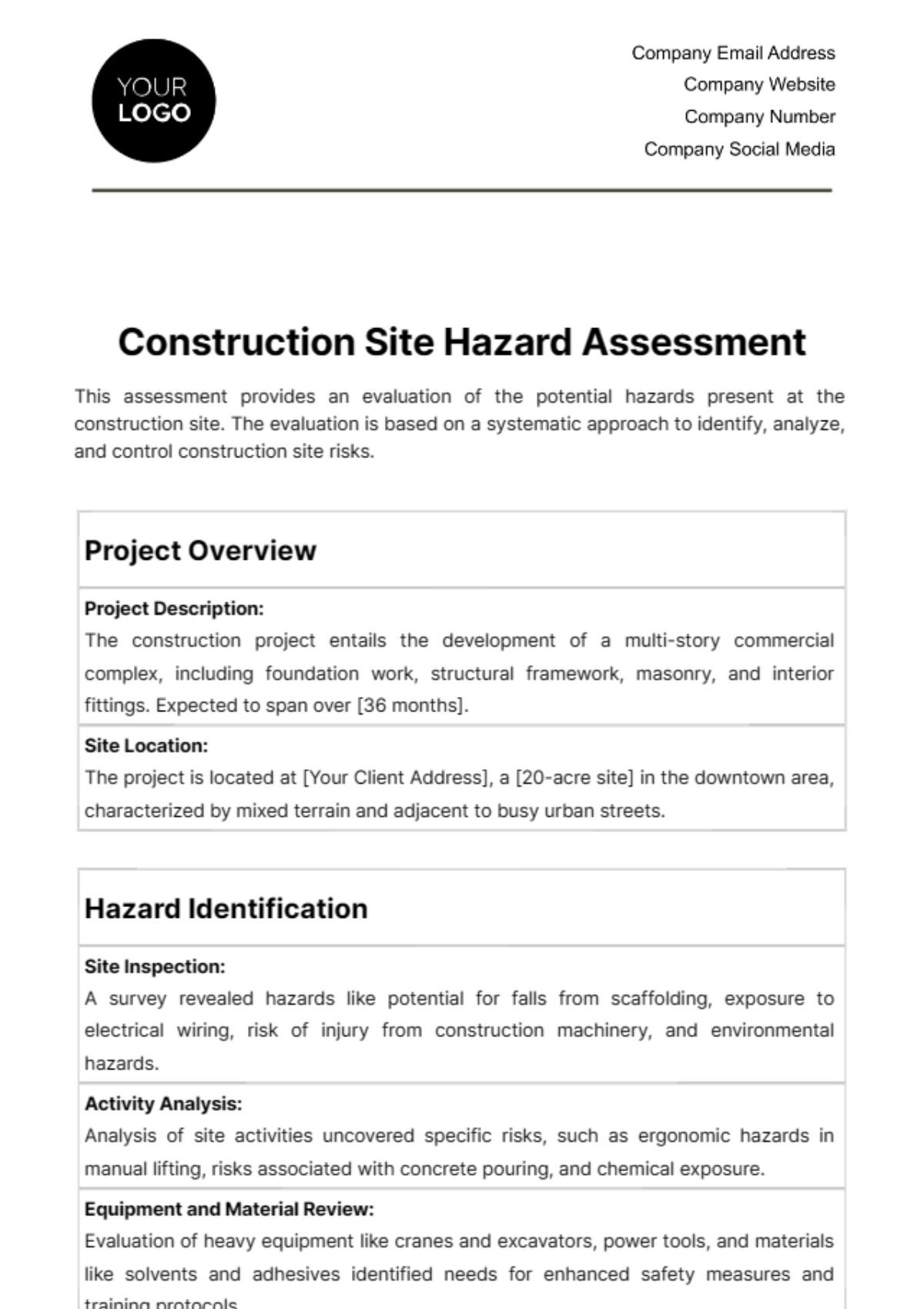Free Construction Site Hazard Assessment

This assessment provides an evaluation of the potential hazards present at the construction site. The evaluation is based on a systematic approach to identify, analyze, and control construction site risks.
Project Overview | |
Project Description: The construction project entails the development of a multi-story commercial complex, including foundation work, structural framework, masonry, and interior fittings. Expected to span over [36 months]. | |
Site Location: The project is located at [Your Client Address], a [20-acre site] in the downtown area, characterized by mixed terrain and adjacent to busy urban streets. |
Hazard Identification |
Site Inspection: A survey revealed hazards like potential for falls from scaffolding, exposure to electrical wiring, risk of injury from construction machinery, and environmental hazards. |
Activity Analysis: Analysis of site activities uncovered specific risks, such as ergonomic hazards in manual lifting, risks associated with concrete pouring, and chemical exposure. |
Equipment and Material Review: Evaluation of heavy equipment like cranes and excavators, power tools, and materials like solvents and adhesives identified needs for enhanced safety measures and training protocols. |
Risk Evaluation | |
Hazard Severity: | Each hazard is categorized based on potential impact, with falls and electrical exposures classified as high risk, and noise pollution as medium risk. |
Likelihood of Occurrence: | Assessments are made considering the daily exposure of workers to these hazards, with historical accident data and industry benchmarks taken into account. |
Vulnerable Groups: | Special consideration is given to identifying groups such as inexperienced laborers, subcontractors unfamiliar with the site, and workers engaged in high-risk activities like working at heights. |
Control Measures | |
Preventative Actions: | Recommendations include implementing a comprehensive fall protection program, regular safety training sessions, installation of noise barriers, and strict protocols for handling hazardous materials. |
Emergency Response Plan: | The plan includes immediate medical response actions, emergency contact procedures, and marked evacuation routes. Regular drills are scheduled to ensure preparedness. |
Monitoring and Review: | An ongoing monitoring system is established to track the effectiveness of the control measures. Regular safety audits and worker feedback sessions are planned for continuous improvement. |
Documentation and Reporting | |
Record Keeping: | All identified hazards, assessments, and implemented control measures are documented. A digital log is maintained for easy access and reference. |
Compliance Verification: | Regular compliance checks are planned to align with national safety standards and local construction regulations. This includes periodic inspections by external safety auditors. |
Review and Update Schedule: | The assessment document is scheduled for review and updates every [six months] or in response to significant changes in construction phases, techniques, or site conditions. |
Assessed by:
[Your Name]
[Job Title]
[Month Day, Year]
- 100% Customizable, free editor
- Access 1 Million+ Templates, photo’s & graphics
- Download or share as a template
- Click and replace photos, graphics, text, backgrounds
- Resize, crop, AI write & more
- Access advanced editor
Introducing Template.net's Construction Site Hazard Assessment Template, an essential tool for evaluating workplace safety risks. Fully customizable and editable with our Ai Editor Tool, this template enables construction businesses to tailor hazard assessments to their specific sites. Streamline safety protocols and ensure compliance effortlessly with our user-friendly platform. Simplify hazard assessment and mitigate risks effectively with this comprehensive template solution.





























